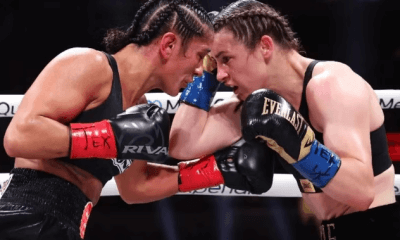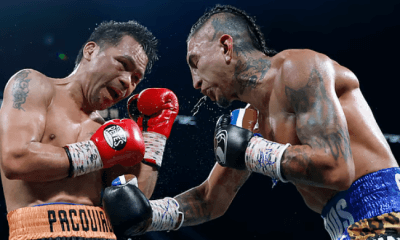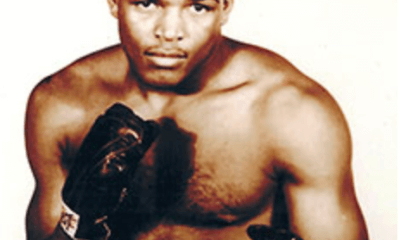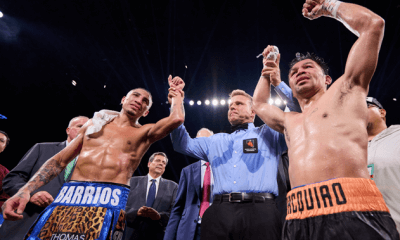Articles of 2005
Recall and the Rematch
Expectations are always high when the rematch of a sensational fight looms. This is the case for the Diego Corrales-Jose Luis Castillo fight on Saturday.
Can Corrales and Castillo match their thrilling first-fight? Is it even fair to expect them to?
Rocky Graziano and Tony Zale topped their first-fight brawl in a furious rematch, but the second Joe Louis-Billy Conn and Rocky Marciano-Jersey Joe Walcott fights were duds that followed two of the best heavyweight title bouts in history.
By rematches I mean the second fight, which disqualifies a bout such as the “Thrilla’ in Manila” between Muhammad Ali and Joe Frazier and does not count the third through 20th matches between Jack Britton and Ted “Kid” Lewis.
Conditions change between the first and second fights, as can mind sets. The fierceness of the first bout can effect a fighter’s approach to the rematch, especially if he is capable of changing his style. After being knocked down twice and almost stopped in the 10th round after fighting inside, which is Castillo country, why would the taller Corrales not try to fight from outside on Saturday?
There would appear to be little doubt that Walcott, then 39, had Marciano’s power very much in mind when he tried in 1953 to regain the heavyweight championship he lost to Marciano in 1952. Walcott was knocked stone cold in the 13th round by arguably the most famous right-hand punch ever thrown. In the rematch, Jersey Joe was knocked out in the first round.
Walcott did not move until the count of 8, and Jesse Abramson wrote in the New York Herald Tribune that Jersey Joe sat there “like an old man resting in the park on the grass and reviewing his past life.” Walcott got up an instant after referee Frank Sikora counted 10. A lot of people thought he could have beaten the count. The Walcott camp cried “fast count,” a cry that echoes throughout boxing history.
The passage of time had a lot do with the Louis-Conn rematch in 1946 falling far shot of Louis’ 13th round knockout when Conn was on the verge of a major upset in 1941. Neither man had fought since 1942 and neither was the fighter he had been in 1941, but time had treated Conn more harshly than Louis.
Before being knocked out in the eighth round, Conn shook Louis with a right to the head in the second round, and he landed a hook to the head and a combination hook to body and head in the third round. The rest of the time, Conn tried to stay out of harm’s way, and he was named “Flop of the Year” in what then was annual Associated Press poll.
The second fight against Conn was one of eight rematches in which Louis was involved. He won all of them, including six by knockout in title defenses. His most famous rematch was a one round knockout of Max Schmeling in a politically charged atmosphere in 1938. Schmeling was seen by many Americans as a representative of Nazi Germany.
In Detroit’s Paradise Valley section, fans displayed a banner proclaiming, “Joe Louis Knocked Out Hitler.”
Still another heavyweight championship rematch that was a dud, at least if you paid to see it, was Muhammad Ali’s first-round knockout of Sonny Liston with a right hand that some observers called a perfect punch and others termed a phantom punch in 1965. Because of that punch or non-punch the fight became part of boxing lore.
A rematch of historical significance was Floyd Patterson’s fifth-round knockout of Ingemar Johansson in 1960 that made Patterson the first man to regain the heavyweight championship.
Sometimes the difference in skill levels between two fighters works against a rematch being nearly as good as the first fight. That was the case of Archie Moore and Yvon Durelle. In 1958, Durelle knocked down the light heavyweight champion three times in the first round and once in the fifth, but Moore rallied and knocked down the Canadian three times before knocking him out in 11th round. The chance of Durelle surprising Moore did not exist in the rematch in 1959 when the champion scored a third-round knockout after putting Durelle down four times.
The mind set of both Tony Zale and Rocky Graziano was such that a rematch between them was much anticipated. So on the night of July 16, 1947, a sweltering crowd of 18,547 in Chicago Stadium paid a then indoor record $422,918 to see if they could match the thrills of their first fight, which was “Fight of the Year” in 1946. In that fight, Graziano was down and almost out in the first round and Zale was on the floor when the bell sounded at the count of 3 in the second round. Zale also was in deep trouble in the third and fifth rounds before knocking out Graziano with a right to the body and left hook to the jaw in the sixth round.
Zale, who had held the middleweight title since 1941, was in control in the first four rounds of the rematch, knocking Graziano down in the third round and ripping a cut over his left eye. Then in the fifth round, Graziano began a battering of Zale that did not end until the fight was stopped late in the sixth.
Carmen Basilio also was involved in two rematches that closely resembled first fights as action packed.
After stopping Tony DeMarco in the 12th round and winning the welterweight championship in 1955, Basilio knocked out DeMarco in 12th round of the rematch the same year. One difference was Basilio was comfortably ahead in the first fight, but he was clearly behind in the rematch.
In 1957, Basilio won the middleweight title on a split decision over Sugar Robinson, with referee Al Berl voting for the loser. Robinson won the rematch in 1958 on a split decision, with referee Frank Sikora voting for the loser.
Although the verdict was different, the Lou Ambers-Henry Armstrong lightweight title rematch in 1939 closely resembled their first fight in action and in the actions of the referees.
Armstrong, already featherweight and welterweight champion, became the first man to hold three titles simultaneously when he won a split decision over Ambers despite being penalized three rounds by referee Billy Cavanaugh for what James P. Dawson of the New York Times called “accidental fouls.”
In the rematch, Ambers became the first man to regain the lightweight championship, winning a unanimous decision (12-3, 8-6-1, 12-3) after referee Arthur Donovan took five rounds from Armstrong for low blows. Dawson thought Donovan was overzealous in applying the foul rule. “On this observer’s score sheet Armstrong was the victim of an injustice . . . Giving Ambers the benefit of the doubt in the five rounds he won by the ring’s law enforcement, Armstrong still won the battle eight rounds to seven in this writer’s opinion,” Dawson wrote.
Some rematches will always be remembered for incidents that occurred during the fights:
Jack Dempsey failing to go immediately to a neutral corner and allowing Gene Tunney to be on the canvas for 14 seconds in the “Battle of the Long Count” won by Tunney in 1927.
Roberto Duran suddenly saying “No Mas” and quiting in the eighth round against Sugar Ray Leonard in 1980
Fan Man crashing against the ropes during the seventh round and causing a 21-minute delay in Evander Holyfield’s majority decision win over Riddick Bowe in 1993.
Mike Tyson biting Holyfield’s ears and getting disqualified after three rounds in 1997.
-

 Featured Articles4 weeks ago
Featured Articles4 weeks agoResults and Recaps from New York Where Taylor Edged Serrano Once Again
-

 Featured Articles2 weeks ago
Featured Articles2 weeks agoThe Hauser Report: Zayas-Garcia, Pacquiao, Usyk, and the NYSAC
-

 Featured Articles4 days ago
Featured Articles4 days agoOscar Duarte and Regis Prograis Prevail on an Action-Packed Fight Card in Chicago
-

 Featured Articles4 weeks ago
Featured Articles4 weeks agoResults and Recaps from NYC where Hamzah Sheeraz was Spectacular
-

 Featured Articles3 weeks ago
Featured Articles3 weeks agoManny Pacquiao and Mario Barrios Fight to a Draw; Fundora stops Tim Tszyu
-

 Featured Articles4 weeks ago
Featured Articles4 weeks agoPhiladelphia Welterweight Gil Turner, a Phenom, Now Rests in an Unmarked Grave
-

 Featured Articles2 weeks ago
Featured Articles2 weeks agoArne’s Almanac: Pacquiao-Barrios Redux
-

 Featured Articles1 week ago
Featured Articles1 week agoRemembering Dwight Muhammad Qawi (1953-2025) and his Triumphant Return to Prison














